What is Tweed: Simple Guide to the Timeless Wool Fabric
Ever seen a stylish jacket or a cozy hat that looks warm and has a classic, slightly rough look? Chances are, it might be tweed! This article will simply explain what tweed fabric is, where this famous fabric comes from, and what makes it so special and loved.
If you’ve ever wondered about tweed, or want to learn about this unique material, you’re in the right place. We’ll explore tweed fabric, providing clear information that helps define it and understand its wonderful qualities.
1. What Exactly is Tweed? The Basics
1.1 Defining Tweed Fabric
Tweed is a type of woven fabric (fabric made by interlacing two sets of yarns at right angles) that is most often made from wool. Think of it as a strong, warm material that feels a bit rough and is made by weaving wool threads closely together. Traditionally, tweed is made from 100% sheep’s wool.
But today, you can also find wool-based textiles that are called tweed but are blended with other fibers. These could be natural fibers like cotton, or man-made ones like nylon or polyester. Blending can change how the tweed feels, make it stronger, or sometimes make it less expensive. The main idea, however, is a sturdy, warm fabric that starts with wool threads. This material composition (what it’s made of) is what gives tweed its famous qualities.

1.2 Key Characteristics of Tweed
- Texture/feel: Tweed usually feels a bit rough or ‘nubby’ when you touch it; it’s not super smooth like silk or cotton t-shirt material. The texture/feel can be quite coarse (very rough) or a little softer. This depends on the kind of wool used to make it and how it’s woven. Often, you can see little knots or thicker bits of yarn in the fabric. These are part of its unique character and charm.
- Material: Classic tweed is made from 100% wool yarn. Often, this wool comes from sheep breeds known for their sturdy wool, like Cheviot or Shetland sheep. This virgin wool (wool that hasn’t been processed or used before) is what gives tweed its natural warmth and toughness. Sometimes, other fibers are blended in. For instance, Merino wool, which is much softer, might be added to make the tweed feel less scratchy. Or, a synthetic fiber like nylon might be mixed in to make the fabric even more durable or to lower the cost. The material composition is very important to how the tweed performs.
- Weave: Weave simply means how the threads are crossed over and under each other to create the fabric. Imagine threads going horizontally and vertically, and the pattern they make where they meet. Tweed often uses a twill weave (a weave that creates a diagonal pattern). A twill weave creates diagonal lines or ridges in the fabric, which you can often see if you look closely. Another common one is a plain weave, which is a simpler, more basic criss-cross pattern. Famous tweed patterns (e.g., Herringbone, Houndstooth) are actually created by specific ways of weaving the threads, often using variations of the twill weave structure.
- Weight and warmth: Tweed is generally a medium to heavyweight fabric. This means it feels quite substantial and not flimsy. Because of its weight and the fact it’s usually made of wool, tweed is very warm. This makes it excellent for outerwear like jackets and coats, especially in cool or cold weather. It’s also known for being weather-resistant. This means it can offer some protection from wind and light rain or drizzle, which is one reason it has always been popular in places with unpredictable weather, offering a major benefit.
1.3 Visuals
The images above, placed near their relevant text, help show the unique look and structure of tweed. Clear captions explain what you are seeing.
2. Where Does Tweed Come From? A Little Bit of History
2.1 The Birthplace of Tweed
Tweed originally comes from Scotland (origin) and also from Ireland. These are its traditional homes. The name ‘tweed’ is famously linked to the River Tweed, which flows through the Scottish Borders region. Another idea is that the name came from the Scots word ‘tweel,’ which is their name for twill – one of the common weaves used to make the fabric.
These areas of Great Britain and Ireland had a cool, damp climate. People living there needed strong, warm, and durable clothes to protect them from the weather. This history of British and Irish textiles shows how the local environment helped shape this unique fabric. Scottish farmers originally wore tweed for warmth and protection while working outdoors. So, the geographic origins: Scotland, Ireland are very central to what tweed is.
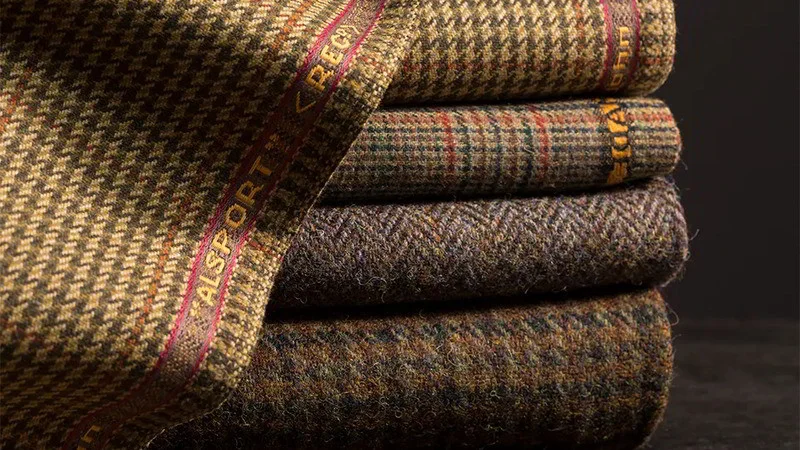
2.2 Traditional Uses
In the very beginning, tweed was the fabric of choice for farmers and other people who worked outdoors in the often harsh conditions of Scotland and Ireland. It was perfect for them because it was warm, very tough, and could handle rough weather like wind and drizzle, making it ideal outerwear.
Over time, tweed also became popular for country activities like hunting, shooting, and fishing, particularly among the British upper classes. Wealthy landowners in Scotland even began creating their own unique tweed patterns for their estates. These were called estate tweeds. These estate-specific patterns functioned much like a uniform, helping to identify people who lived, worked, or were guests on a particular estate.
3. How Tweed is Crafted?
Making tweed is a careful process that has been refined over generations. It turns raw sheep’s wool into the strong, beautiful fabric we know. Here’s a simple look at the main steps:
- Cleaning and carding: First, the raw wool that comes from the sheep is cleaned thoroughly to remove dirt and grease. Then, it’s ‘carded.’ Carding is a process where the wool fibers are brushed with special tools so they all lie in roughly the same direction, getting them ready for spinning.
- Spinning: The carded wool fibers are then spun into wool yarn. Spinning twists the fibers together to make a continuous thread.
- Dyeing: The yarn is often dyed in various colors. This dyeing stage is very important for tweed because these different colored yarns are later woven together. This is what creates tweed’s famous flecked, heathered, and multi-tonal look, rather than just one solid color.
- Weaving: The dyed yarns are then woven into fabric on a machine called a loom. This is where textile weaving techniques are used to create the specific structure and pattern of the tweed.
- Finishing: Finally, the woven fabric goes through a finishing process. It’s usually washed, and sometimes pressed or treated, to give it its final look, feel, and stability.
It’s interesting to note that some special tweeds, like certain genuine Harris Tweeds, still have a handwoven origin, meaning they are woven by hand in the traditional way, while most tweed today is made on modern machines.
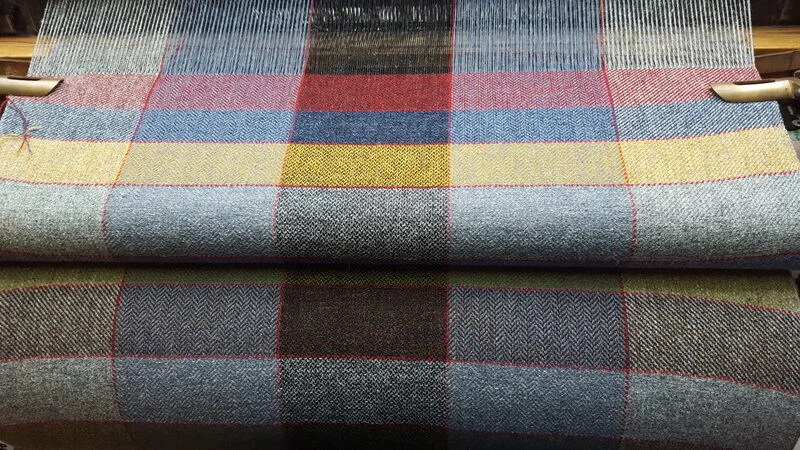
4. Types of Tweed You Might See
Tweed isn’t just one single type of fabric; there are many different kinds, each with its own special look, feel, and story. Here are a few of the most famous examples you might come across:
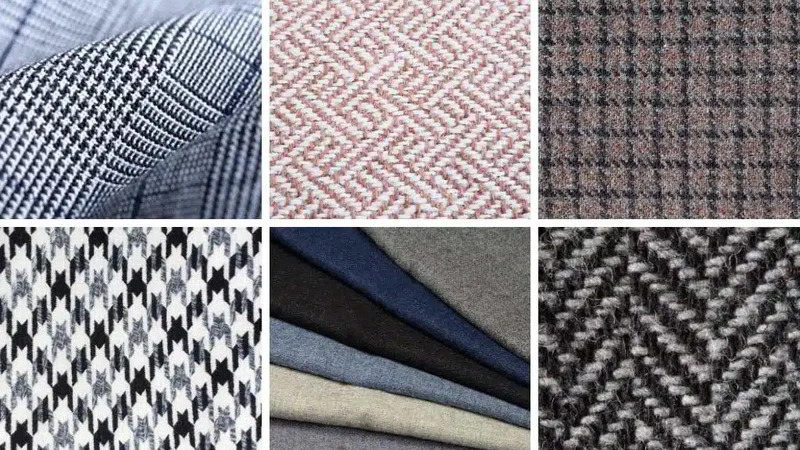
4.1 Harris Tweed
Harris Tweed is very special and famous worldwide. To be called Harris Tweed, it must meet strict rules. It must be handwoven by islanders in their own homes in the Outer Hebrides of Scotland (origin). It must also be made from pure virgin wool that is dyed and spun in these same islands.
It’s protected by a British law called the Harris Tweed Act of 1993, and genuine Harris Tweed always has a special label with an Orb mark to prove it’s real. Harris Tweed is protected by the Harris Tweed Act. It’s known for its amazing quality, rich colors, and durability.
Its handwoven origin makes each piece unique. Many people ask ‘what is Harris Tweed used for?’ Commonly used for high-quality items, Harris Tweed is popular for high-quality jackets, coats, hats, bags, and even home furnishings.
4.2 Donegal Tweed
Donegal Tweed comes from County Donegal in Ireland (Geographic Origins: Ireland). Its most famous feature is the colorful little flecks or slubs (thicker bits) of yarn that are scattered all through a plain-weave fabric. These flecks look like tiny bits of colorful confetti and give Donegal Tweed its unique, lively, and slightly rustic appearance. It’s a very distinct and well-loved member of fabric types: Donegal Tweed.
4.3 Herringbone Tweed
Herringbone isn’t a specific type of wool or origin, but a very popular weave (Herringbone) pattern found in many tweeds. It looks like a series of V-shapes or zig-zags stacked neatly together. The pattern gets its name because it looks like the bones of a herring fish – hence the name Herringbone.
This pattern (e.g., Herringbone) is very classic and often used in tweed jackets/suits, coats, and skirts. The V-shaped weave pattern of Herringbone Tweed is easily recognizable and gives a smart, traditional look.
4.4 Houndstooth Tweed
Houndstooth is another famous pattern often found in tweed. Like Herringbone, it refers to the way the fabric is woven or printed. It’s made of broken, pointy checks, which some say look a bit like a dog’s tooth (hence ‘houndstooth’).
It’s often seen in two contrasting colors, like black and white, but many other color combinations are also used. The pattern (e.g., Houndstooth) can be small and subtle or large and bold, and it creates a very smart and eye-catching look.
4.5 Cheviot Tweed
Cheviot tweed is made from the wool of Cheviot sheep, a hardy breed that originally comes from the Cheviot Hills between England and Scotland. This wool is known for being quite crisp, firm, and very durable. It’s not as soft as some other wools like Merino.
As a result, Cheviot tweed often has a slightly rougher texture/feel compared to tweeds made from finer wools. It’s very tough and wears well, making it great for hard-wearing garments. It’s a good example of how the specific type of wool used directly influences the final fabric types and their characteristics.
5. What is Tweed Used For? Fashion and Beyond
5.1 Clothing
Tweed is most famously used in clothing, where its combination of style, warmth, and durability makes it a popular choice.
- Jackets/suits and blazers: Classic tweed jackets or blazers are very popular for both men and women, offering a timeless smart-casual look. Full tweed suits are also a traditional and stylish choice. The best type of tweed for jackets often depends on the desired warmth and texture – a heavier Cheviot for rugged outdoor wear, or a softer blend for a more refined city jacket.
- Overcoats: Heavyweight tweed makes wonderfully warm and protective overcoats for cold weather.
- Skirts and dresses: Tweed skirts and dresses are common in women’s fashion, offering a chic and structured look.
- Trousers: Tweed trousers are durable, warm, and can be very stylish for both men and women.
- Vests (waistcoats): Tweed vests, also known as waistcoats, add a smart layer to an outfit and are often worn with tweed suits or jackets.
- Hats: Traditional hats like flat caps, deerstalkers, and some fedoras are often made from tweed.
These are all common apparel fabrics applications within various garment categories.
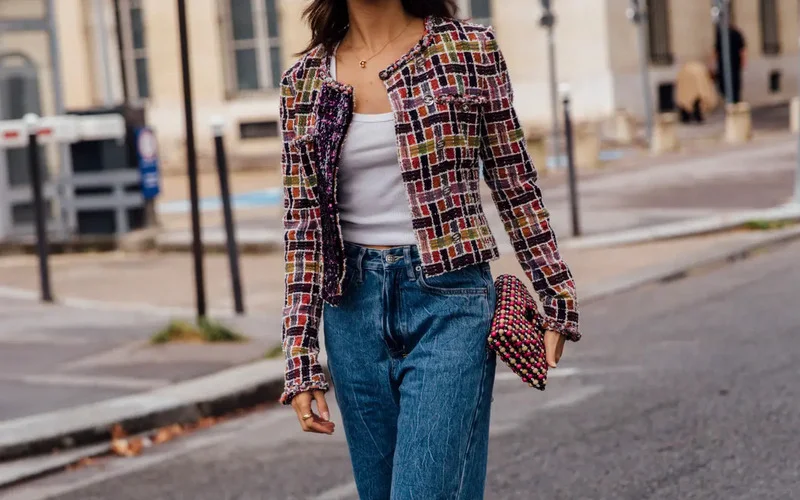
5.2 Accessories
Tweed is not just for big clothing items; it’s also used for a range of stylish accessories:
- Bags: Its toughness makes it great for durable and fashionable bags, from handbags to travel bags.
- Scarves: Tweed scarves provide excellent warmth and add a touch of classic style.
- Gloves: Tweed gloves, often lined with softer material, offer extra warmth for hands in cold weather.
5.3 Home Furnishings
While not as common as it is for clothes, tweed’s durability and attractive texture make it suitable for some home items, especially those that need to be hard-wearing. Examples include sturdy upholstery on armchairs or sofas, and decorative cushions that add a cozy, rustic touch to a room.
5.4 Chanel’s Influence
The famous fashion designer Coco Chanel played a very big role in making tweed popular in women’s fashion, moving it beyond its traditional masculine and country image. In the 1920s, she was inspired by the practical tweed fabrics worn by men and began using tweed, which was mostly a men’s fabric at the time, for her revolutionary women’s suits and jackets.
Chanel (fashion influence) helped to transform tweed into a symbol of chic, comfortable, and modern style for women. Her iconic tweed jackets are still sought after today. Coco Chanel’s use of tweed in fashion designs is a key moment in the history of tweed in fashion.
6. Why Do People Love Tweed?
People have loved and worn tweed for generations, and it continues to be popular today. Here are some of the main reasons why:
- Durability: Tweed is very strong and made to last. A good quality tweed item can be worn for many years, often becoming even more characterful with age.
- Warmth: Being mostly made from wool, it’s excellent for cold weather, keeping you warm and cozy. Traditional wool tweed is also somewhat weather-resistant to light wind and rain.
- Timeless style: Tweed has a classic, enduring look that never really goes out of fashion. It can look traditional or modern depending on how it’s styled, but it’s always considered stylish.
- Unique character: The special textures, the rich mix of colors from the dyed yarns, and the famous patterns of tweed give it a lot of personality and make each piece feel unique.
- Natural fiber (mostly): Traditional tweed is made from wool, which is a renewable and biodegradable resource. This makes it one of the sustainable and natural fiber options, an appealing choice for those who prefer natural materials.

7. Caring for Your Tweed Items
To keep your tweed clothing and accessories looking their best for many years, it’s important to take good care of them. Here are some simple tips for caring for your tweed clothing items:
- Check the label: First and foremost, always look at the care label on your tweed garment. It will have specific instructions from the manufacturer.
- Brushing: After wearing, use a soft clothes brush to gently brush off any surface dirt, dust, or lint. Brush downwards. This helps keep the fabric fresh and prevents dirt from settling in.
- Spot cleaning: If you get a small spill or stain, try to deal with it quickly. Gently blot the stain with a clean cloth and cold water or a mild wool-safe detergent. Don’t rub hard, as this can damage the fibers. Always test on a hidden spot first.
- Airing: Let your tweed clothes air out properly after wearing them, especially if they’ve become damp from rain or humidity. Hang them somewhere with good air circulation but away from direct sunlight or heat.
- Storage: Store tweed items in a cool, dry place to prevent mildew or moth damage. Use good quality, shaped hangers for jackets and coats to help them keep their shape. Avoid overcrowding in your closet.
- Dry clean: For most tweed coats, suits, and other structured items, dry cleaning by a professional who has experience with garment care for wool items is often the safest and best option. Avoid machine washing heavy wool tweed unless the care label specifically permits it, as it can cause shrinkage, felting (matting of fibers), or distortion.
8. Identifying and Choosing Tweed
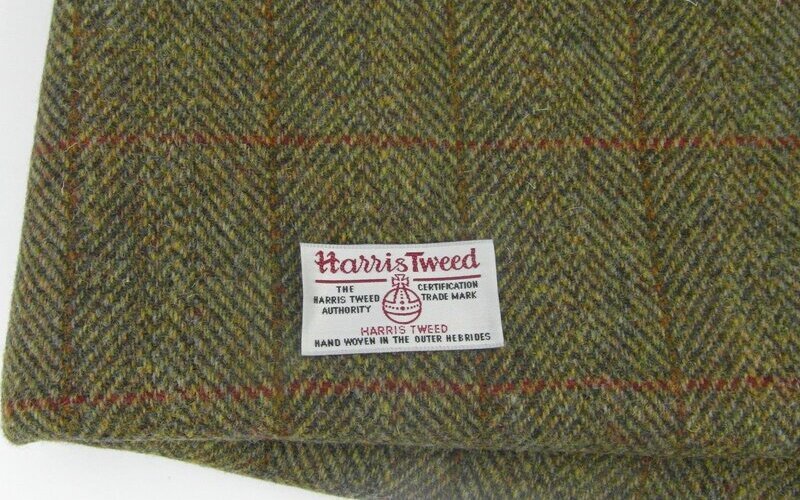
8.1 How to Identify Real Tweed
With so many fabrics out there, you might wonder ‘how to identify real tweed fabric?’ Here are some simple clues to look for:
- Feel it: Real tweed, especially traditional types, usually has a distinctly ‘wooly’ or slightly rough texture/feel. It shouldn’t feel overly smooth, flat, or synthetic (like plastic).
- Look closely at the yarns: You should be able to see the weave (like the diagonal lines of a twill, or the pattern of a Herringbone). Often, you’ll see many different colors of yarn flecked and mixed together, not just one flat, uniform color. This complex color is a hallmark of quality tweed.
- Check the label: The garment or fabric label should tell you what it’s made of. Look for ‘100% wool’ or a high wool content. If it claims to be Harris Tweed, look for the official Orb mark label – it’s a guarantee of authenticity.
- Resilience (springiness): Wool tweed usually has a natural resilience. If you gently crumple a corner in your hand and then release it, it should spring back into shape without holding onto deep creases too much.
8.2 Quality and Branding for Tweed Items
Tweed is widely seen as a high-quality, premium material with a rich history and a reputation for craftsmanship and durability. It speaks of tradition and lasting style. Because of this, brands that choose to use real tweed for their products often want their overall product presentation – including things like labels, tags, and packaging – to match this same level of quality and attention to detail. Branding for high-quality apparel becomes very important.
When you have a garment or accessory made from such a distinguished fabric, a well-crafted woven label (a label made by weaving threads together, like on clothing necklines), an elegant hang tag (a tag attached to a product, usually made of card), or thoughtful packaging can significantly enhance its perceived value and communicate the brand’s commitment to excellence. These details complement the heritage and craftsmanship associated with tweed.
At Packlove, we often advise clients that when choosing labels for tweed garments or similar premium items, selecting options that reflect the fabric’s robust, natural, and unique character is a smart approach. For example, a damask woven label with intricate detail, or a thick, textured kraft paper hang tag with embossing (creating a raised design on a surface), can beautifully echo the tactile nature of tweed and reinforce the brand’s quality story. It’s about creating a cohesive experience where every element, from fabric to label, speaks the same language of quality.
Read more:
So, what is tweed fabric? As we’ve seen, it’s much more than just a type of material. It’s a strong, warm, and characterful wool fabric with a deep and fascinating history, born in the rugged, beautiful landscapes of Scotland and Ireland.
With its lasting style, incredible durability, and unique textures and patterns, tweed has remained a favorite for generations, used for everything from practical country outerwear to high fashion statements. Whether it’s found in a classic tailored jacket, a cozy winter hat, or a stylish modern accessory, tweed continues to prove that true quality, craftsmanship, and timeless style are always in fashion.
At Packlove, we believe that quality products deserve quality branding. If you create items with the same dedication to craftsmanship and lasting value embodied by fabrics like tweed, we can help you present them perfectly.
Ready to elevate your brand’s presentation? Explore Packlove’s custom labels, tags, and packaging solutions designed to match your product’s excellence. Have questions or need advice on the best branding options for your products? Contact our friendly Packlove team today for a personalized consultation!

















